Fresh Summer Rolls with Peanut Ginger Sauce
Vietnamese-style fresh summer rolls are colorful, crunchy, and so easy to make! Serve these as a light meal or easy summer appetizer with sweet-spicy homemade peanut sauce for dipping.
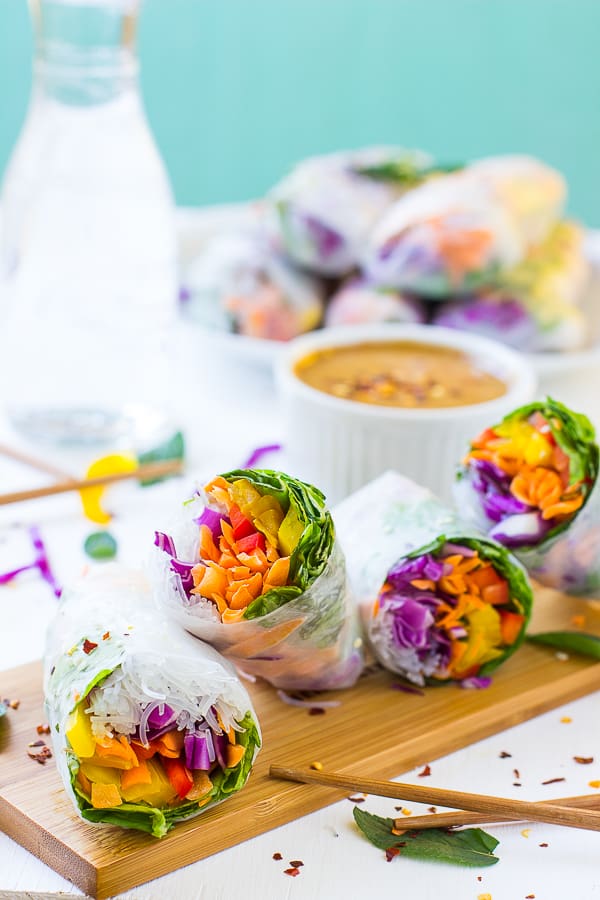
I love a rainbow of veggies. I mean, just look at these fresh summer rolls! Vietnamese-style rice paper rolls are packed with colorful crunch. Everything gets chopped, layered, and rolled up inside a tight little rice paper burrito that’s perfect for dipping. I serve these with my favorite peanut ginger sauce (recipe included below), but you can dip them in anything you’d like.
Why You’ll Love These Fresh Summer Rolls
- Fresh and colorful. There’s no better way to eat the rainbow than a stack of fresh summer rolls. I make mine with crisp green lettuce, juicy red peppers, crunchy carrots, and purple cabbage. Of course, it wouldn’t be a summer roll without fresh vermicelli noodles, so you’ll find them in there, too.
- Perfect for summer. I love making fresh summer rolls in the summertime. There’s no cooking involved, and the flavors are delicious, especially when local veggies are in season.
- Versatile. These summer rolls are great for lunch or dinner, or I’ll make a big batch of them to bring out when we have company over. They’re the ultimate light and easy meal, snack, or appetizer. You can even let your guests DIY their rolls.
- Quick. Best of all, Vietnamese summer rolls are quick to assemble with just a few ingredients. Buy julienne (matchstick cut) veggies from your grocery store to save time on chopping!
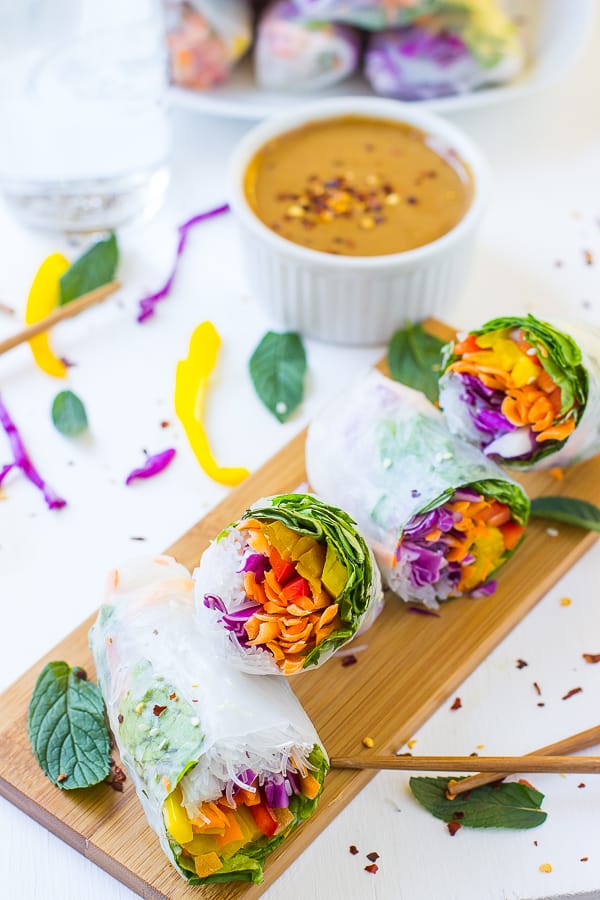
Ingredient Notes
Fresh summer rolls take minutes to make with ingredients you’ll find in most major grocery stores. I’ll go over the important ingredients with some notes below. Scroll to the recipe card for a printable list with the full amounts you’ll need.
- Rice paper spring roll wrappers – These can be found in the grocery aisle with other Asian ingredients. They may sometimes be labeled “spring roll skins” or simply “spring roll wrappers”. Unlike wheat-based egg roll wrappers, they’re made with rice flour and tapioca starch.
- Vegetables – Choose your own rainbow! I use a combination of thinly sliced carrots, red and yellow bell peppers, purple cabbage, and butter lettuce. Spinach or spring greens will work, too.
- Fresh herbs – I love fresh mint in these rolls. Basil or cilantro are also good options, or you can use any mix of fresh herbs.
- Rice vermicelli noodles – These are long, thin Asian rice noodles. Not to be confused with Italian vermicelli, which is pasta. I usually find rice vermicelli in the same aisle as the rice paper wrappers.
- Peanut Sauce – For dipping. I’ve included the recipe for my homemade Thai peanut sauce. The recipe calls for soy sauce, but you can use liquid aminos, coconut aminos, or tamari if needed.
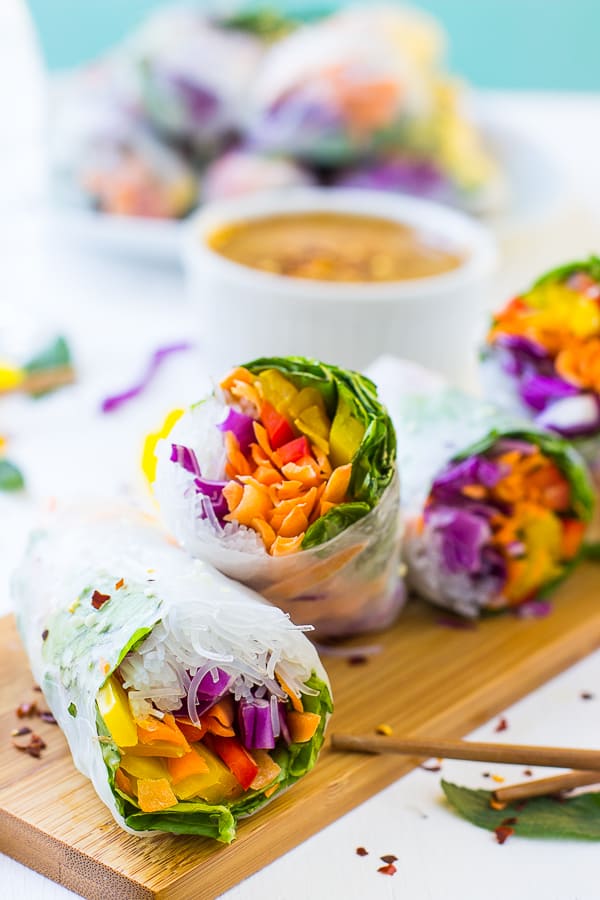
How to Make Fresh Summer Rolls
First things first, cut up all your veggies ahead of time so you have a mise en place (everything set out) for filling your rolls. Layer on your ingredients any way you like. I usually group each ingredient rather than mixing everything up, for more visual impact. Then, wrap the rolls tightly. Tight wrapping is key here!
How to Wrap Summer Rolls
Once you’ve filled the middle of your wrapper with vegetables, noodles, and herbs, here’s the best way to wrap your fresh summer rolls:
- Fold the top and bottom of the wrapper over the filling.
- Next, roll tightly from left to right, like a burrito. Place the finished roll on a plate with the seam-side down. The rice paper will be sticky and should stay in place.
- Repeat with the remaining rolls.
Your first few rolls will probably be a little wonky (it happens to me, too!), but after you get the hang of it, you’ll find the process easy… and even a little bit satisfying! Once you’re a rolling pro, you’ll want to make my Summer Fruit Spring Rolls, too.

Easy Peanut Dipping Sauce
I love this peanut ginger sauce and I use it in plenty of recipes, from these fresh summer rolls to my tempeh stir fry and Asian noodle salad. It’s simple to make. Take out a bowl, and whisk together peanut butter, maple syrup, soy sauce, and white or rice vinegar with ground ginger, sesame seeds, red pepper flakes, and a bit of warm water. Once the sauce is smooth, you’re ready to serve.
Tips for Success
Here are some hints and tips for making fresh summer rolls even easier.
- Saving on prep time. If your grocery store has a salad bar, buy the filling ingredients from there to save yourself time slicing and julienning.
- Amping up the protein. You can swap the rice noodles for strips of cooked tofu. Or, add a protein like vegan chicken, crispy tofu, or tempeh to your rolls in addition to the noodles.
- A note on work surfaces. The rice paper wrappers will stick to wood, so you’ll want to use a plastic or silicone board, or a plate for assembly. Otherwise, line a wood cutting board with a damp paper towel.
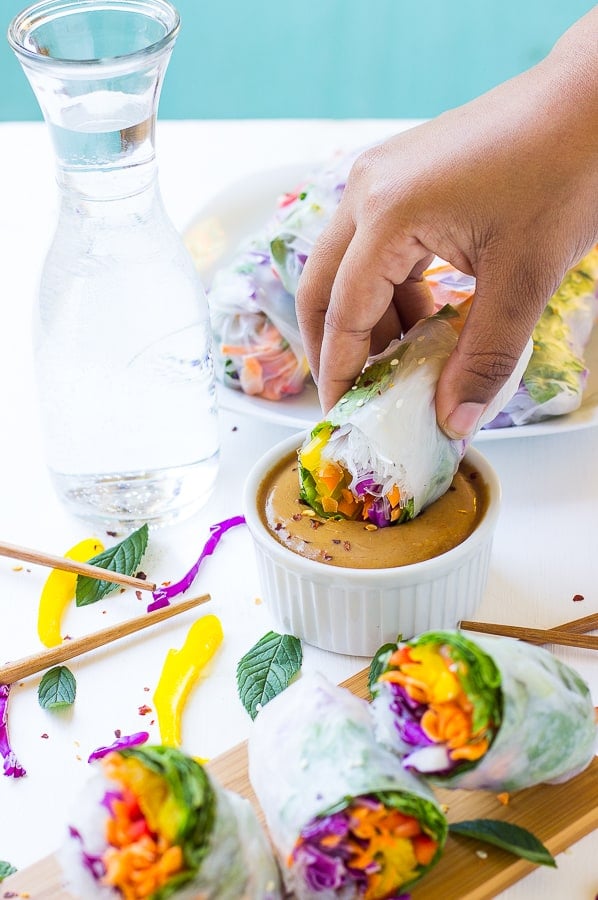
Serving Suggestions
Fresh summer rolls dipped in spicy peanut sauce are the perfect light snack all on their own. Or, I’ll serve these alongside Thai coconut curry soup or vegan pad see ew to turn them into a meal. I also love the summery flavors of this pineapple fried rice or this quick Asian-inspired quinoa salad.
How to Store
Store fresh summer rolls in an airtight storage container in the refrigerator with a damp paper towel separating them to keep them from drying out. The sauce can also be refrigerated. Both will keep in the fridge for 3 to 4 days, depending on the freshness of the veggies you use. Summer rolls are great for meal prep!
Can These Be Frozen?
No, this isn’t a recipe that will freeze well. If you’re looking for a freezer-friendly Asian appetizer, try my Vegan Potstickers instead!
P.S. Here are some of the items I used to make this recipe if you’d like to use them too:
| WHAT YOU’LL NEED // SHOP MY FAVORITE INGREDIENTS & PREP PRODUCTS |
Enjoy friends! If you make this fresh summer rolls recipe, please snap a photo and tag #jessicainthekitchen on Instagram! We’d also love it if you would leave a comment below, and give the recipe a rating! Thanks so much!
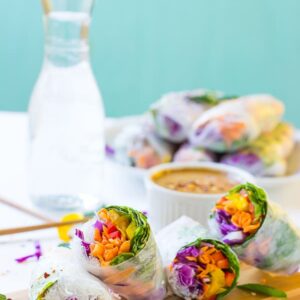
Fresh Summer Rolls with Peanut Ginger Sauce
Ingredients
Fresh Spring Rolls
- 9-10 rice paper
- 1 carrot, julienned
- ¼ cup chopped mint
- 2 cups purple cabbage, (171g) sliced
- ½ cup red bell pepper, (52g) chopped
- ½ cup yellow bell pepper, (52g) chopped
- 7-8 lettuce leaves
- 5 ounces rice vermicelli noodles, (140g) cooked
Peanut Ginger Sauce
- ½ teaspoon ground ginger
- 1 tablespoon maple syrup
- 2 tablespoon soy sauce, gluten free if needed, or liquid aminos or coconut aminos or tamari
- 1 teaspoon distilled white vinegar
- ½ teaspoon sesame seeds
- ⅓ cup natural peanut butter
- ¼ cup warm water
- ¼ teaspoon crushed red pepper flakes
Instructions
Peanut Ginger Sauce
- Whisk all the ingredients together in a deep bowl until combined. Set aside until ready to use.
Fresh Summer Rolls
- Chop up your veggies and place on a cutting board.
- Prepare the rice paper wrappers as per the instructions on your packaging. I poured water into a large wide bowl. I then dipped the rice papers into the water, until they began to become completely transparent. You want to ensure it’s soft, but not so soft that it can be easily ripped. For my rice papers, this was about 20-30 seconds.
- I then removed from the water and onto a plastic, silicone or ceramic cutting mat (they seemed to stick to my wooden board – if you only have a wooden cutting board, you can lay down a damp paper towel on it) and slightly pat dry.
- Fill your rolls! I placed 2-3 slices of the varying bell peppers, a few slices of julienned carrots, some cabbage, a handful of vermicelli noodles, a sprinkling of mint and a small handful of lettuce (basically 1/10th of the amount I have in total). I lined these up in the centre of the rice paper.
- I rolled the top and bottom of the rolls over the filling, then from left to right. So I rolled the left of the rice paper over the filing, then began to tuck the filling in as I rolled towards the right like a burrito. I continued to roll tightly until finished, then lay them on the folded edges to set on a plate. This took me about 30-45 seconds to do including putting in the filling.
- Serve on a plate with the dipping sauce and enjoy!
Notes
Disclaimer: Although jessicainthekitchen.com attempts to provide accurate nutritional information, kindly note that these are only estimates. Nutritional information may be affected based on the product type, the brand that was purchased, and in other unforeseeable ways. Jessicainthekitchen.com will not be held liable for any loss or damage resulting for your reliance on nutritional information. If you need to follow a specific caloric regimen, please consult your doctor first.






I am making 30 of these for a party and wondering if you had any ideas on how I can store these overnight so they don’t stick to each other.
Hi Stacy,
We haven’t tried this so we can’t guarantee but I think on a really wide platter side by side not sticking with some moist paper towels underneath them so they don’t stick to the platter or maybe on several plates with the same paper towel in the fridge. We hope you enjoy!!
Delicious! The peanut sauce is addicting
So happy that you like the peanut sauce Mae. Thanks so much for reading and reviewing!
This was SO good! I’ve made spring rolls before but the mint and rice noodles made such a big difference in taste and texture! The peanut sauce was really good too, I used minced ginger and ‘regular’ peanut butter because that’s what I had. I think the regular peanut butter probably made the sauce a bit thicker than it would have been with natural but it was still so good and complimented the spring rolls so well. Definitely will be making these again!
I have wanted to make spring rolls for a long time but didn’t feel i could do it. This recipe convinced me to try and I am so happy I did, they were delicious and that sauce is amazing. Thank you!
These spring rolls were so tasty and easy to make. Definitely a new go-to for lunches! Also one of my favorite dipping sauces!
Hi Kelly,
Thank you so much and I’m so happy that you enjoyed so much!!
So yummy, and once you get a hang of wrapping, so easy! I’ve been sharing this recipe with everyone!
We’re so happy to hear that! Thanks so much Melissa.
Can the sauce be made using a nut butter other than peanut?
Hi Kristy thanks so much for reading. It should be able to be made with other nut butters.
Stacey: Have made spring rolls before. To store in fridge and not stick, line plate with waxed paper and make sure they are spaced apart so they can’t touch one another. If making a lot, line a cookie sheet with wax paper and cover with saran wrap before putting in the refrigerator.
I’m excited to make these for a dozen guests at an appetizer party but am unsure about this: is there just one dipping sauce bowl used by everyone or does each guest get their own little dipping bowl? Can you tell me the amount of sauce this recipe makes?
Hi Sonja,
I would suggest doubling or tripling the sauce, then putting one spoon with a larger dipping sauce bowl so everyone can spoon some onto their plate. That way you don’t have to get a dozen bowls. Or you could get a dozen small bowls and divide it up, but the first way will work better and that way there’s no double dipping and everyone can dip into the sauce on their own plate (it’s thick enough for that).